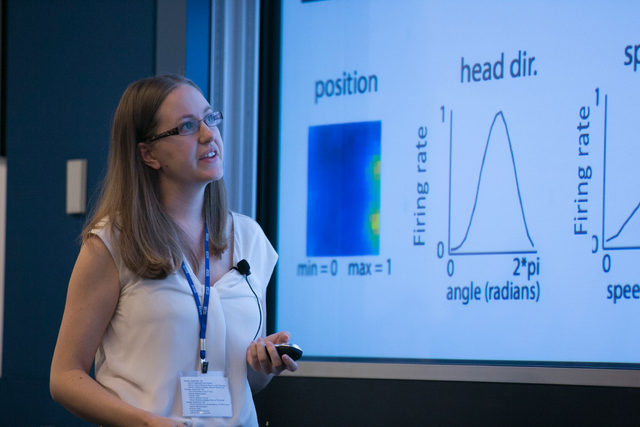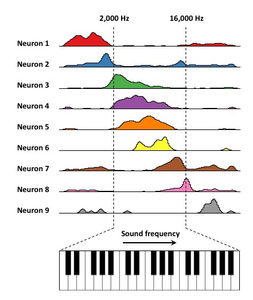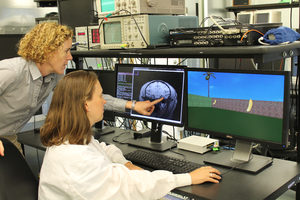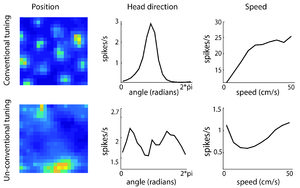Hippocampus’ Navigation System Goes Beyond Spatial Mapping

The hippocampus and the neighboring entorhinal cortex are a marvel of navigation. These brain areas house so-called ‘place cells’ that help animals find their way through a maze and ‘grid cells’ that act as the brain’s internal GPS system, discoveries that earned three scientists the 2014 Nobel Prize in Physiology or Medicine.
But a growing body of research suggests that the navigation systems within the hippocampus and entorhinal cortex might be much more powerful and diverse. Three groups from the Simons Collaboration on the Global Brain have found that cells in the hippocampal circuit seem to map not just space, but also sound, time and other factors. “The findings point to a more general function of the hippocampus — it’s representing the whole experience,” says Dmitriy Aronov, a postdoctoral researcher at Princeton University who will soon join the faculty at Columbia University. “Anatomically, it makes no sense for the hippocampus to be only about space, because it receives information from everywhere in the brain.”
Aronov and David Tank, scientific director of the Simons Collaboration on the Global Brain and a neuroscientist at Princeton University, were inspired to explore a broader role for the hippocampus by a set of virtual reality experiments that they published in Neuron in 2014. Rats ran on a treadmill as the animals navigated a virtual environment, all while an electrode array recorded neural activity from the hippocampal-entorhinal circuit. The researchers found that animals created an internal map of that virtual world — when Aronov slightly rotated the fake environment, hippocampal firing patterns shifted accordingly. “They completely ignored the physical world and locked onto this artificial image of the world,” Aronov says. If the hippocampus can form a representation of an arbitrary virtual construct, he says, “perhaps it can just as well make an organized representation of another kind of a context.”
Last summer, emboldened by Aronov’s faculty job offer from Columbia, the pair decided it was time to test that idea with a high-risk experiment. Aronov trained rats to traverse an auditory rather than a physical space. The animals used a joystick to move through a sort of sound maze — a defined sequence of frequencies. When the rat moved the joystick, the frequency increased and kept increasing for as long as the animal deflected the joystick.
The researchers discovered a set of cells that act very much like place cells. Instead of firing when the animal is in a specific location, these ‘sound cells’ fire when the animal hears a specific tone. “It has the classic pattern of the hippocampal place cell,” Aronov says.
A Significant Sequence
Mapping sound space might seem like an arbitrary task not particularly relevant to real world needs. But Tank, Aronov and others think that the hippocampal circuit might be doing something much more profound: mapping experience more broadly.

A number of scientists have found that cells in the hippocampus and entorhinal circuit produce a predictable sequence of neuronal activity during tasks. Tank and Aronov, for example, found that cells in the hippocampal circuit fired in a predictable pattern during the entire experiment, not just in response to sound. “From pressing the lever to traversing the frequency to receiving the reward and starting a new trial — there is a sequence of activation throughout the entire period of behavior,” Tank says. The sequence probably represents not just sound but other aspects of the task as well, perhaps even abstract concepts, Tank says.
Beth Buffalo and her collaborators at the University of Washington made a similar observation in the primate entorhinal cortex. Primates assess their environment differently than rodents do — whereas rodents physically explore the world by moving through it, primates initially examine their surroundings visually. Buffalo’s team has shown that grid, border and head-direction cells fire when the primate looks at a certain location, sees a visual landmark or makes an eye movement in a specific direction. The findings show that the same neural circuitry can map space during visual or physical exploration, which hints at the flexibility of entorhinal circuits. (Indeed, Tank and Aronov say their sound experiments were inspired in part by Buffalo’s research.)
In their most recent work, Buffalo and her collaborators found that eye movements seem to trigger a sequence similar to the one that Tank and Aronov identified. When the monkey moves its eye to look at something, individual neurons in the hippocampus fire in a characteristic sequence. “Each neuron has a preferred time to fire,” Buffalo says. “If you line them up, they perfectly span the time of a fixation.”

The findings are in line with other studies that uncovered specific firing sequences in the hippocampus and entorhinal cortex. Howard Eichenbaum, a neuroscientist at Boston University, found that neurons in the rat entorhinal cortex fire in a predictable sequence as rats run on a treadmill for a set amount of time. Moreover, the cells are quite flexible. When experimenters lengthen the duration of the experiment, the cells expand their sequence accordingly. When the animals are allowed to forage freely, a task where navigation is more important than time, the same cells respond to location. Eva Pastalkova, now at the Howard Hughes Medical Institute’s Janelia Research Campus in Ashburn, Virginia, and Gyorgy Buzsaki, a neuroscientist at New York University, have found similar patterns.
Taken together, the research suggests that cells in the hippocampus and entorhinal cortex adapt and respond to the most salient features of the local environment. “If the animal is navigating through space, the sequence tends to correspond to space,” Aronov says. “If it’s traveling through sound, the sequence will correspond to successive sounds. That points to a more general function of the hippocampus — It’s not trying to represent sound space, it’s representing the whole experience.”
Scientists don’t yet know the precise function of these sequences — understanding their role in computation in the brain will require further experiments. But given that the sequences have been observed in a wide variety of conditions, they are probably important, Tank says. “One general idea is that they form some kind of abstract representation for experience or action planning.”
Although the new research certainly expands the traditional view of the hippocampus and entorhinal cortex as masters of navigation, it doesn’t contradict any of that research, Tank notes. “It just suggests there is a more general interpretation of all these firing patterns,” he says. “It makes it more interesting.”
Beyond Place and Grid Cells
Most studies of navigation in the hippocampus and entorhinal cortex focus on specific types of cells — grid cells, place cells, head-direction cells and others. However, these cells make up only a small fraction of the neuron population in those brain regions. Lisa Giocomo, a neuroscientist at Stanford University, is developing new ways to study the role of the remaining cells. Her early work, done in collaboration with Surya Ganguli, also at Stanford, suggests that the entorhinal cortex codes for more than simply location. “We think there is more to this region than just the GPS signal,” Giocomo says.

Place cells, grid cells and other cell types are identified by their classic tuning curve — a typical place cell is most active when the animal is in a particular location, and firing rates drop rapidly as the animal moves away. But this approach may miss cells that don’t fit this precise definition.
Giocomo and others are beginning to use alternative methods, based on statistics, to define cells. Rather than looking for cells that code for specific spatial properties, researchers have developed statistical models that determine in an unbiased way which variables best predict whether the neuron will fire.
That approach can capture more subtle coding principles, such as adaptive coding, when cells change their code based on the situation. For example, a cell might be tuned to the orientation of the head when the animal runs slowly but respond to both head direction and position when the animal runs fast.
Giocomo and her collaborators applied this approach to a large dataset of neural activity recorded from freely foraging animals. The researchers analyzed neural activity in each cell in response to the animal’s location, speed and head direction. Their findings suggest that entorhinal cells are encoding information beyond speed and position. Rather than simply being tuned to a single factor, many cells responded to a mix of variables. Moreover, some cells show adaptive coding, altering their coding properties with the animal’s speed. The findings point to these cells as “encoding information beyond path integration,” Giocomo says. “The entorhinal cortex might be involved in more cognitive type behaviors like memory or planning.”
Giocomo points out that this type of unbiased approach will be important for gaining a complete view of the function of the entorhinal circuit. “It is hard to fully understand what role the entorhinal cortex is playing in behavior if we don’t even know what over half of the neurons are encoding,” she says. “This approach allows us to reveal what the majority of neurons are encoding without requiring predefined assumptions for what tuning should look like.”
Taken together, this broader view of the hippocampal and entorhinal circuits might ultimately help scientists create a more cohesive picture of this part of the brain, which has long been known to be crucial for memory. To date, however, research into the memory and navigation functions of the hippocampus have largely proceeded in parallel, and scientists have had trouble synthesizing these two views. Spatial and other types of mapping may turn out to be an integral component of memory, making these circuits even more intriguing.


